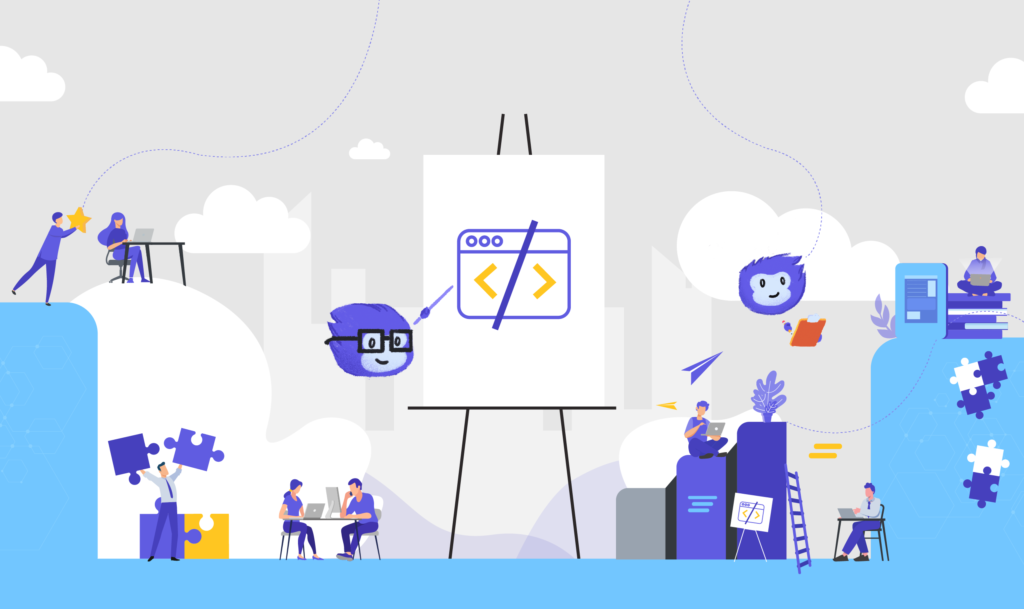No-code automation testing is a trendy technology in quality assurance, which is steadily growing in popularity in recent years. If you’re thinking of implementing it into your testing strategy, make use of our short but pulpy article to grasp the main pros and cons of this hi-tech testing method.
What Is No-Code Test Automation?

Source: forbes.com
No-code testing is a method of test automation, in which scripts are created by a specialized tool without writing a single line of code. This method doesn’t require QA engineers any programming skills, though they still should have a deep understanding of the software testing process and all the product development stages.
No-code testing significantly reduces the amount of time spent on tedious testing scenarios like regression testing, helping to optimize both testers’ and developers’ resources for more complex tasks like product development or UX testing. The types of tests that perfectly fit no-code testing are:
- Day-to-day time-consuming manual tests like regression testing;
- Tests that require a lot of resources from the QA team;
- Flaky tests that lead to inconsistent results like pass and fail for the same configuration or false negatives.
No-Code vs. Code-Based Automation Testing

Source: linkedin.com
So what are the core differences between no-code automation testing and a code-based approach in the course of the testing process? In a code-based model, engineers and testers need to have solid coding skills, as they create test scenarios manually, describe user stories, and then create test scripts in Java. They need to orient the code very well to find the elements that are causing tests to break, fix the code, or create new test cases based on the results gained.
In no-code testing, on the contrary, test cases are created without a single line of code, scenarios are flow-based and exploratory, and testers don’t need to use any coding skills. Thus, even non-technical specialists can easily use these tools, run, modify, and edit scripts, and understand the results clearly.
The Top Benefits of No-Code Automation
The no-code testing strategy provides both QA and programming engineers with numerous benefits, making it an all-in-one solution for a wide range of CI/CD issues development teams face in the course of any project realization. We collected the most important of them in the list below:
1) Speed of testing
No-code solutions are empowered with robust cloud infrastructure, which boosts test execution time and performance significantly. Also, such tools have easy access to any type of platform via globally distributed data centers, which also contributes to overall QA team performance.
2) Tests reusability
All tests once created can be quickly reused, modified, duplicated in other scenarios, edited, or deleted. Thus, team members don’t need to continuously write new test scripts for different scenarios.
3) Collaboration options

Source: netscribes.com
Code-based testing is all about individuals working separately on product optimization, while no-code testing offers impressive collaboration options like working together on a shared project, real-time script editing, commenting, communication, exporting, duplicating of test scenarios, etc., which makes the testing process faster and simpler.
4) Following a CI/CD pipeline
No-code testing allows performing continuous testing and delivering fast feedback to the developers upon any code change. Plus, it supports test execution at scale, test reporting, scheduling, and real-time visual analytics.
5) High operability and scalability
No-code testing tools don’t require any setup, have a small learning curve, and enjoy the unlimited scalability of thousands of on-demand desktop VMs and mobile devices.
How to Choose the Right No-Code Testing Solution

Source: tonkean.com
Choosing the fitting no-code testing tool for your company can greatly optimize not only your QA strategy and team resources, but enhance the entire CI/CD process. That’s why in order to choose a perfectly fitting tool you need to understand your current testing landscape, and the existing challenges, and know what requirements a no-code tool should cover.
We also recommend paying attention to the most time-consuming testing tasks you have, as automating them through a no-code tool will greatly free up your team. Plus, it’s good to choose the tool AI components, visual testing, detailed analytics, and reporting features, as the future of testing is all about dashboards and visual analytics.
Try No-Code Testing Right Now With DogQ

Source: dogq.io
For QA and programming teams who want to implement no-code automation tools into their testing strategy, we can recommend trying DogQ, as it offers the following benefits:
- DogQ is extremely user-friendly, as even a person with no technical skills can start using it for creating test scenarios in an hour;
- It makes the web app testing process much easier and quicker, building multiple automation scenarios without a single line of code;
- DogQ works ideally with cutting-edge front-end frameworks like React and Angular;
- It provides you with all types of functional and UI testing needed to check the general functionality and graphical interface of any app;
- It automates and fastens regression testing in times, freeing your team up of this daunting task;
- It has robust collaboration options like working in team, tests re-use and sharing, as well as modifying any previous cases to be used in new scenarios;
- DogQ has a visual dashboard with key metrics that enables you to track all the project progress in real-time;
Thus, it provides all the necessary flexibility, performance, and scalability needed to ensure QA, while staying user-friendly, intuitive, and easy to navigate even for non-technical team members.
Summing Up
No-code testing is a new word in the IT industry, but due to its multiple benefits like enhanced scalability, high testing speed, improved collaboration, and test reusability its rapidly gaining popularity both among companies and individual engineers.
You need to analyze your testing needs, challenges, and set clear requirements in order to choose the fitting tool among a huge variety of solutions available in the market. We recommend paying attention to solutions powered with AI and visual analytics like DogQ no-code testing tool, as they can provide rich opportunities for your testing strategy.



